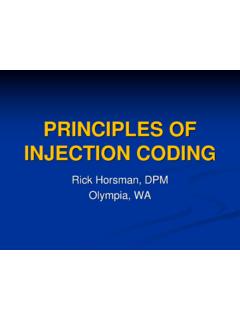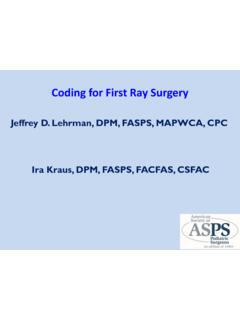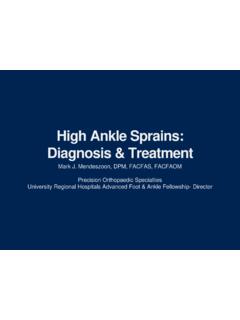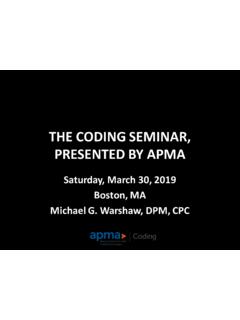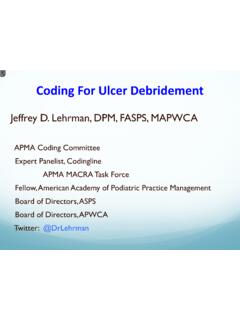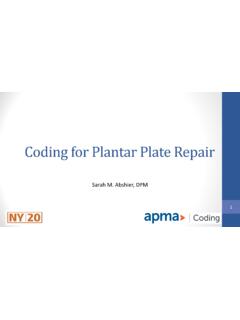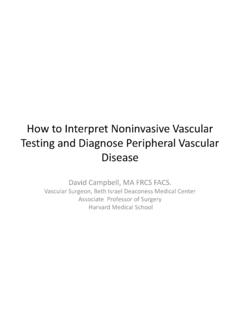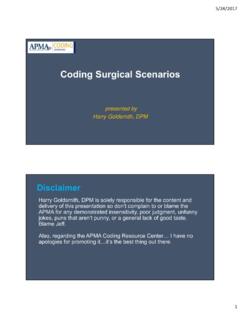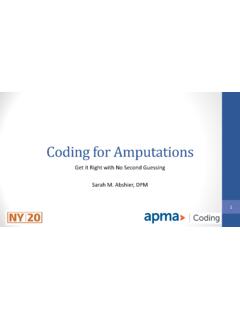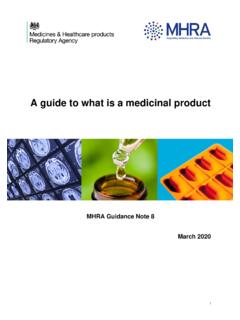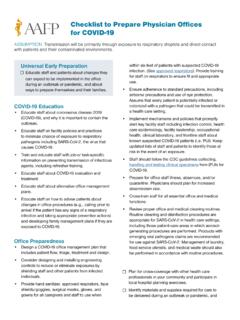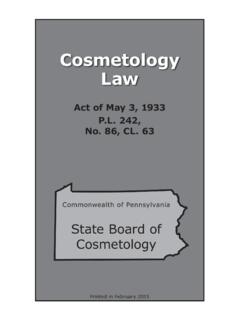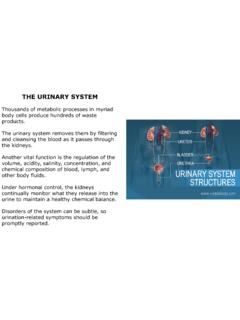Transcription of Coding for Wound Care - apma.org
1 Coding for Wound Care **IMPORTANT** Disclaimer **Information provided is to the best of our knowledge and as current as possible. **Please verify all policy and reimbursement information with your local Medicare carriers. Physicians and other providers must confirm or clarify Coding and coverage from their respective payers, as each payer may have differing formal or informal Coding and coverage policies or decisions. Physicians and providers are responsible for accurate documentation of patient conditions and for reporting of procedures and products in accordance with particular payer requirements. Does location matter? Laterality does not matter Anatomical location does matter There are codes for the Leg (including the ankle) Foot and toes Size and Code Selection Clarification Select debridement codes based on the deepest level of tissue debrided Debridement codes should only be based on the measurement of the Wound surface that was actually debrided When the entire Wound is debrided, the Wound measurement after debridement should be reported When multiple wounds are debrided at the same depth, combine the debrided surface measurements of all same tissue depth wounds Do not bill each Wound separately BUT document each depth of Wound separately DEBRIDEMENT CODES NOT INVOLVING SUBCUTANEOUS TISSUE 97597 Removal of devitalized tissue from wounds, selective debridement, without anesthesia, Wound assessment, topical applications, instructions for ongoing care.
2 Total Wound surface area first 20 sq cm ---May include scalpel, scissors, waterjet 97598 each additional 20 sq cm THESE CAN BE BILLED TOGETHER SIZE REFERS TO TOTAL SURFACE AREA OF ALL WOUNDS WITH NO MODIFIER DEBRIDEMENT CODES INVOLVING SUBCUTANEOUS TISSUE AND DEEPER 11042 Debridement, subcutaneous tissue incl epidermis and dermis, first 20 sq cm or less 11045 each additional 20 sq cm The above 2 can be billed together with no modifier as it is an add on code BE AWARE OF PLACE OF SERVICE LIMITATIONS CHECK YOUR LCD s!!!!!! DEBRIDEMENT CODES INVOLVING SUBCUTANEOUS TISSUE AND DEEPER 11043 Debridement, musle and/or fascia incl epidermis and dermis and subQ, first 20 sq cm or less 11046 each additional 20 sq cm The above 2 can be billed together with no modifier as it is an add on code BE AWARE OF PLACE OF SERVICE LIMITATIONS CHECK YOUR LCD s!
3 !!!!! DEBRIDMENT CODES INVOLVING SUBCUTANEOUS TISSUE AND DEEPER 11044 Debridement, bone , incl subcutaneous tissue, muscle, and/or fascia, epidermis and dermis, first 20 sq cm or less 11047 each additional 20 sq cm The above 2 can be billed together with no modifier as it is an add on code BE AWARE OF PLEACE OF SERVICE LIMITATIONS CHECK YOUR LCD s!!!!!! Use Add-On Codes When Debrided Tissue at the Same Depth Is Greater Than 20 sq. cm. Use Multiple Codes When Different Tissue Depths Are Debrided on Different Wounds 2012 Changes in Skin Substitute Coding Familiar skin substitute CPT codes (32 of them) were deleted on January 1, 2012, and replaced with two broad anatomic groups of codes: one representing trunk, arms, legs, and the other representing face, scalp, eyelids, mouth, neck, ears, orbits, genitalia, hands, feet, and/or multiple digits.
4 Each of the two anatomic groups of codes include 4 new CPT codes based on the Wound size range assigned to each code. Skin Preparation Codes The surgical preparation codes, CPT 15002-15005, are to be used for the initial traumatic Wound preparation (removal of appreciable nonviable tissue) and cleaning to provide a viable Wound surface (primary intention healing) for placement of an autograft, flap, skin substitute graft or for negative pressure Wound therapy. CPT 15002-15005 are NOT to be used for the removal of nonviable tissue/debris in chronic wounds left to heal by secondary intention. CPT 11042-11047 and CPT 97597-97598 are to be used for this. CPT 15002-15005 are selected based on the anatomic area and size of the prepared/debrided defect.
5 For multiple wounds, the choice of code is based on the aggregate sum of the surface area of all similarly grouped Wound types Skin Substitute Grafts Application of skin substitute grafts, according to the 2012 CPT, include non-autologous human skin (dermal or epidermal, cellular and acellular) grafts, non-human skin substitute grafts ( , xenograft), and biological products that form a sheer scaffolding for skin growth. These codes are NOT reported for injected skin substitutes (for example: Graftjacket Express, Integra matrix should be reported with the unlisted code 15999). 15002-15005 NOTE: Debridement is separately reimbursed on the date of application only when there is extensive cross contamination that requires prolonged cleansing , and appreciable amounts of devitalized or contaminated tissue is removed; or if the debridement is obvious to be medically necessary and performed separately without immediate primary closure, do not report debridement and Wound prep on the same day for the same wounds Skin Substitute Graft Wound Area Grouping Coding The two size groups are: Small Wounds - for wounds known to have an aggregate Wound size up to a maximum of 100 sq cm.
6 The codes represent the first 25 sq. cm and additional 25 sq. cm* up to that maximum 100 sq cm Wound area. Large Wounds - for wounds known to have an aggregate Wound size beginning at 100 sq cm or greater. Small Leg/Ankle Wounds CPT 15271 (application of skin substitute graft to, for example, leg or ankle). This code is based on a Wound size (after cleansing , prepping, and/or debriding) maximum of 100 sq cm. Specifically, this code is to be used for application of a skin substitute graft to a Wound surface area size of 0 to 25 sq cm (first 25 sq cm within the maximum Wound size grouping up to 100 sq cm). If the leg/ankle Wound area is greater than 25 sq cm, but less than the maximum of group size up to 100 sq cm, then bill CPT 15271 plus CPT 15272 for each additional 25 sq cm of Wound surface area.
7 The total Wound surface area treated cannot exceed 100 sq cm so you have the ability to bill CPT 15272 3 times, for example, if skin substitute graft material is applied to up to 100 sq cms of leg/ankle Wound (s). Since CPT 15272 is an add-on code, you would NOT apply a -51 modifier. It is already discounted Large Leg/Ankle Wounds CPT 15273 (application of skin substitute graft to, for example, leg or ankle). This code is based on a Wound size (singular or aggregate size; after cleansing , prepping, and/or debriding) minimally of 100 sq cm*. Specifically, this code is to be used for application of a skin substitute graft to a Wound surface area size of 100 up to 200 sq cms (the code itself represents the first 100 sq cm of a large leg/ankle Wound treated).
8 If the leg/ankle Wound area is greater than 100 sq cm, then bill CPT 15273 plus CPT 15274 for each additional 100 sq cm* of Wound surface area. For example, if you have an aggregate sum of leg/ankle Wound area calculated to be 375 sq. cm present bilaterally, you would bill CPT 15273 (first 100 sq cm), CPT 15274 (next 100 sq cm), CPT 15274 (next 100 sq cm), and CPT 15274 (next 75 sq cm). Since CPT 15274 is an add-on code, you would NOT apply a -51 modifier. It is already discounted. Small Foot/Toe Wounds CPT 15275 (application of skin substitute graft to, for example, foot or toe(s)). This code is based on a Wound size (after cleansing , prepping, and/or debriding) maximum of 100 sq cm. Specifically, this code is to be used for application of a skin substitute graft to a Wound surface area size of 0 to 25 sq cm (first 25 sq cm within the maximum Wound size grouping up to 100 sq cm).
9 If the foot/toe Wound area is greater than 25 sq cm, but less than the maximum of group size up to 100 sq cm, then bill CPT 15275 plus CPT 15276 for each additional 25 sq cm of Wound surface area. The total Wound surface area treated cannot exceed 100 sq cm so you have the ability to bill CPT 15272 3 times, for example, if skin substitute graft material is applied to up to 100 sq cms of foot/toe Wound (s). SinceCPT 15276 is an add-on code, you would NOT apply a -51 modifier. It is already discounted. Large Foot/Toe Wounds CPT 15277 (application of skin substitute graft to, for example, foot or toe(s)). This code is based on a Wound size (singular or aggregate size; after cleansing , prepping, and/or debriding) minimally of 100 sq cm*. Specifically, this code is to be used for application ofa skin substitute graft to a Wound surface area size of 100 sq cm and up, but the code itself represents the first 100 sq cm of the foot/digit Wound (s) treated.
10 If the foot/toe Wound area is greater than 100 sq cm, then bill CPT 15277 plus CPT 15278 for each additional 100 sq cm* of Wound surface area. For example, if you are treating a patient with an aggregate sum of foot/toe Wound area calculated to be 375 sq. cm present bilaterally, you would bill CPT 15277 (first 100 sq cm), CPT 15278 (next 100 sq cm), CPT 15279 (next 100 sq cm), and CPT 15278 (next 75 sq cm). Since CPT 15278 is an addon code, you would NOT apply a -51 modifier. It is already discounted. Code Description 15777 Implantation of biologic implant ( , acellular dermal matrix) for soft tissue reinforcement ( , breast, trunk) (List separately in addition to code for primary procedure) This is ONLY to be used for breast reconstruction A CPT code for implantation of skin substitutes may be requested if enough multispecialty usage is done over the next 2-3 years CPT Code for Implantation of Biologic Implants Common Podiatric Examples #1 Physician applied a skin substitute graft: 10 sq cm diabetic foot ulcer on the right heel 1 unit of 15275 (up to 25sq cm foot) #2 Physician applied skin substitute grafts.
